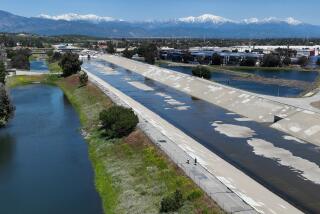‘Rainwater Harvest’ Aids Dry Regions
- Share via
AUSTIN, Texas — In the drought-scorched landscape of the West, some Texans have found a Biblical solution to their water problems: rainwater harvesting.
At her home 30 miles west of Austin, Suzy Banks lovingly pats her three fiberglass tanks containing 13,000 gallons of what she calls “my water.”
For the last two years, Banks and her husband have relied solely on rainwater that is collected from her roof and sent through a maze of pipes into the tanks. Even if it doesn’t rain a drop for six months, they will have plenty of water.
Across Texas, the ancient, low-tech cistern is making a comeback. Half a dozen regional vendors sell cisterns and rainwater-collection systems. It’s estimated that 200,000 cisterns are in use in the United States.
J. Hari Krishna, the president of the American Rainwater Catchment Systems Assn., says the interest in cisterns is simple: “There’s a finite amount of water and the population keeps increasing. Thus, there is a greater need to find alternate water resources.”
But the rainwater renaissance extends beyond U.S. borders. In the Middle East, scientists have begun promoting cisterns as a sustainable source of water. Anthropologist Oystein LaBianca of Andrews University in Barrien Springs, Mich., has spent the last four summers in Jordan refurbishing ancient cisterns.
“The purpose of this work is to recover an indigenous body of knowledge that is on the verge of becoming extinct,” says LaBianca via telephone from Amman, Jordan. With the help of the Adventist Development and Relief Agency, LaBianca has restored more than 30 cisterns, the oldest of which dates back 5,000 years. Most “were probably built by the Romans, who were great cistern builders,” he says.
Over the centuries, as centralized water delivery systems were built, people stopped collecting rainwater. “It was easier to turn the tap on,” says LaBianca.
The benefits of cisterns are many: They reduce reliance on expensive dam projects; they reduce power demand for water pumps; and the water doesn’t need to be chemically treated.
Cisterns and rainwater catchments are standard in new construction on tropical islands like the U.S. Virgin Islands and Bermuda. A handful of tropical resorts now tout their rainwater-collection systems as an environmentally friendly method of water supply. The World Bank is also getting in on the act, financing construction of cisterns in China and Egypt.
More to Read
Sign up for Essential California
The most important California stories and recommendations in your inbox every morning.
You may occasionally receive promotional content from the Los Angeles Times.










